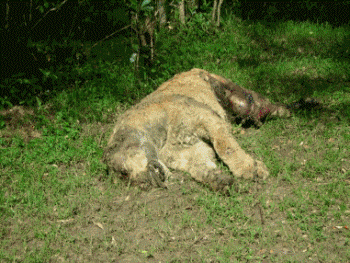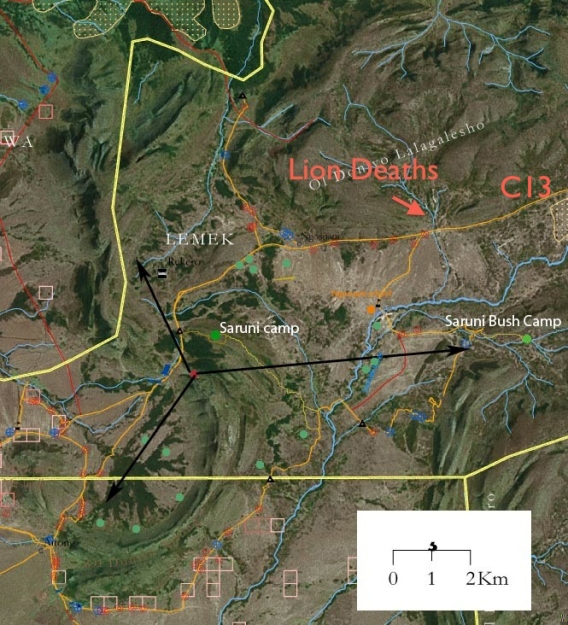Eight lions have been poisoned to death in a month in Kenya, according to conservation organization WildlifeDirect. Locals, frustrated by lions killing their livestock, have taken to poisoning the great cats using a common pesticide in Kenya called carbofuran, known commercially as Furadan.
Last month in Amboseli National Park an entire pride of lions—five in total—died after eating bait that had been laced with carbofuran. A hyena was poisoned as well in what is believed to be a revenge-killing. Later in April three additional lions were poisoned to death in the Masai Mara Park. In this case, the perpetrator was caught and arrested. But he has since been released.
The Kenyan Wildlife Service (KWS) estimated that 1,970 lions survive in Kenya while stating that “poisoning is perhaps the greatest threat to predators and scavenging birds.” Scavenger birds also succumb to the poison when farmers or herders lace a livestock corpse with it. It is believed that birds may have died by the millions from the pesticide, because farmers spread it over their fields which birds subsequently feed off. Farmers have even been known to use it to kill birds they consider pests, some will eat the birds or sell them for food.
 Poisoned lion in Kenya. Photo courtesy of WildlifeDirect. |
The toxicity of carbofuran was brought home tragically to the Kenyan public last year when a three-year-old boy consumed the poison and died. Her father, a primary school teacher, had bought the pesticide for his garden.
“The future of tourism in Kenya is at risk if dangerous pesticides like carbofuran (sold locally as Furadan) remain on the market. Time and again, we’ve seen these substances used to slaughter our national heritage and destroy one of our greatest economic assets. Yet the authorities continually fail to follow up cases of abuse and prosecute the culprits. The Kenyan government must show that it is serious and take swift action to ban deadly pesticides like Furadan and enforce the law,” said chairman of Wildlife Direct and renowned conservationist, Dr. Richard Leakey. “If we fail to put a stop to poisonings, our lions could go extinct in a matter of years; a catastrophic loss for anyone who cares about our national heritage, but also a devastating blow to the tourism industry that currently brings in hundreds of millions of dollars to our economy.”
WildlifeDirect has long been campaigning against carbofuran in Kenya. The Kenyan government is currently considering a ban, alhough WildlifeDirect warns it may be years before it is approved.
While all forms of carbofuran have been banned in the US and the EU, the pesticide is manufactured in Philadelphia, Pennsylvania by Farm Machinery and Chemicals (FMC).
Although beloved animals to many, lion populations have been falling precipitously over the last century, down from over 100,000 lions at the beginning of the century to approximately 39,000 in 2002. Poisoning, spearing, habitat loss, decline in prey, and even climate change are thought to be behind the species’ decline. The lion is currently listed as Vulnerable by the IUCN Red List.
Last year the KWS warned that ‘the king of the jungle’ could vanish entirely from Kenya in 20 years, if action isn’t taken to better protect the cat.

Map shows where lion killings have occurred in Kenya. Courtesy of WildlifeDirect.
Slideshow about lions and Furadan in Kenya produced by Wildlife Direct.
Footage of bird in Kenya being poisoned with Furadan and then clubbed to death for human consumption.
Related articles
Why top predators matter: an in-depth look at new research
(02/02/2010) Few species have faced such vitriolic hatred from humans as the world’s top predators. Considered by many as pests—often as dangerous—they have been gunned down, poisoned, speared, ‘finned’, and decimated across their habitats. Even where large areas of habitat are protected, the one thing that is often missing are top predators. However, new research over the past few decades is showing just how vital these predators are to ecosystems. Biologists have long known that predators control populations of prey animals, but new studies show that they may do much more. From controlling smaller predators to protecting river banks from erosion to providing nutrient hotspots, it appears that top predators are indispensible to a working ecosystem. Top predators sit at the apex of an ecosystem’s food chain. Wolves in Alaska, tigers in Siberia, lions in Kenya, white sharks in the Pacific are all examples of top predators.
Prime Minister of Kenya urged to ban lion-killing pesticide after child dies from ingestion
(11/10/2009) On Monday October 26th a three-year-old girl mistakenly ate the pesticide Furadan (also known as carbofuran) in western Kenya. Her father, a teacher at a primary school, said that he had no knowledge of how dangerous the pesticide was, which he had purchased to kill pests in his vegetable garden.
Kenya’s pain, part two: decades of wildlife decline exacerbated by drought

(10/20/2009) Not many years ago if you were planning a trip to Africa to see wildlife, Kenya would be near the top of the list, if not number one. Then violent riots in late 2007 and early 2008 leaving a thousand dead tarnished the country’s image abroad. When calm and stability returned, Kenya was again open for tourism, and it’s true that most travelers were quick to forget: articles earlier this year announced that even with the global economic crisis Kenya was expecting tourism growth. However, a new disaster may not be so quickly overcome.
